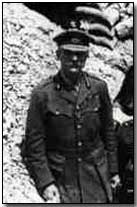Who's Who - Sir Aylmer Hunter-Weston
 Sir Aylmer Gould
Hunter-Weston (1864-1940) served as a British commander in the Gallipoli
campaign in 1915.
Sir Aylmer Gould
Hunter-Weston (1864-1940) served as a British commander in the Gallipoli
campaign in 1915.
Hunter-Weston joined the Royal Engineers in 1884 and served on the Indian Northwest Frontier where he was wounded. He was also to serve in Egypt and in South Africa during the war of 1899-1902.
In 1911 Hunter-Weston was appointed Assistant Director of military training. Upon the outbreak of war in August 1914 he was commanding a brigade which he subsequently took to France to serve on the Western Front.
Despatched to Gallipoli to aid Sir Ian Hamilton's campaign, Hunter-Weston was given command of 29th Division and later 8th Corps. His continuing - and unjustified - optimism when planning attacks led to his forces sustaining heavy casualties.
Invalided back to England in July 1915 (from sunstroke and nervous strain) Hunter-Weston - who was knighted in 1915 and elected to the House of Commons as a Unionist MP for north Ayrshire in October 1916 - returned to France where he led VIII Corps during the Somme Offensive. It was Hunter-Weston's unit which suffered the greatest number of casualties on 1 July 1916, while failing to achieve any of its objectives.
To a large extent this can be attributed to his decision to fire off two mines earlier than planned (two and ten minutes prior to the infantry assault), thereby warning the Germans opposite him of his impending attack. His next major command came only as the war drew to a close.
Leaving the army in 1919 Hunter-Weston (known as 'Hunter-Bunter') continued to pursue his political career. He died in 1940.
A 'Woolly Bear' comprised a German shrapnel shell, which burst with a cloud-like explosion.
- Did you know?
